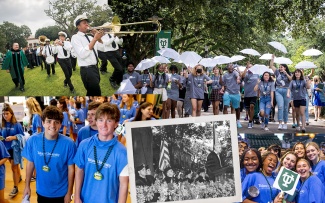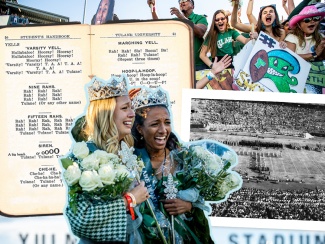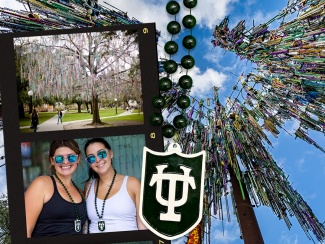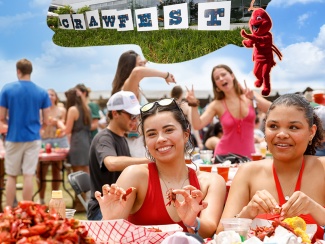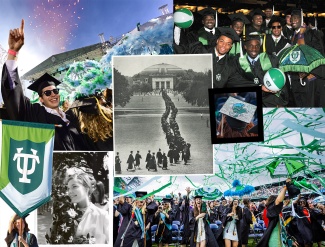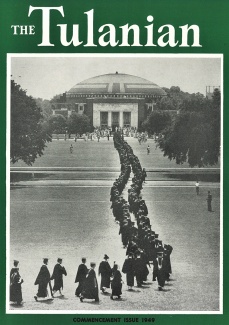Commencement: The grand finale
Tulane’s oldest tradition is Commencement. Although Tulane’s first graduating class was in 1836, Case said her research indicates that the first joint Commencement ceremony didn’t take place until March 22, 1852. That event only included what was then known as the Medical Department of the University of Louisiana and the Law Department. There were no graduates of the Collegiate Department — all of Tulane’s other academic disciplines — until 1857. In 1908, Tulane had its first Commencement Week with the first Unified Commencement Ceremony, glee club concerts, performances by the Mandolin and Guitar Club, and a senior play.
Today, Tulane’s Unified Commencement is a New Orleans-themed affair, complete with second-lining, live jazz and Mardi Gras beads. Graduates enter the ceremony venue waving sparkly green and blue parasols, usually the same ones they were given as first-year students and encouraged to decorate over their four years at Tulane. Keynote speakers have come from the world of entertainment, business and politics, and have included the likes of Apple CEO Tim Cook, actress Helen Mirren and former Presidents George H.W. Bush and Bill Clinton. Honorary degree recipients have included Irma Thomas, Steve Gleason, U.S. Rep. John Lewis and Branford Marsalis.
Many of Tulane’s individual schools as well as Newcomb Institute have their own graduation traditions. Under the Oaks is hosted by Newcomb Institute to honor student and faculty award recipients. The ceremony opens with the procession of the Daisy Chain, which consists of over 1,000 daisies gathered by the members of the junior class.
Other traditions include the Order of the Coif inductions, hosted by Tulane Law School to honor its highest-ranking students, and a second-line parade for doctorate and master’s graduates of the Tulane School of Public Health and Tropical Medicine. Because so many public health students hail from countries outside the United States, a collection of international flags is traditionally placed at the rear of the stage.
If there’s one thing that almost all graduates enjoy, it’s donning their cap and gown and having their pictures taken on the Tulane sign outside Gibson Hall.
For recent Tulane graduate Payton Doyal, the Unified Commencement tops all other Tulane traditions. He said this year’s ceremony was especially meaningful because he and some of his classmates were unable to experience a typical high school graduation due to the COVID-19 pandemic. That he was honored with the role of gonfalon bearer made the ceremony even more special.
“Being able to participate in Commencement, both walking across the stage at my school-specific ceremony and being a gonfalon bearer, was the perfect representation of these past four years of hard work,” said Doyal, who will be attending Tulane Law School in the fall.
“For many, this tradition marks the end of their time at Tulane. It is one of the most significant moments for a Tulane student and holds a very special place in our hearts.”


